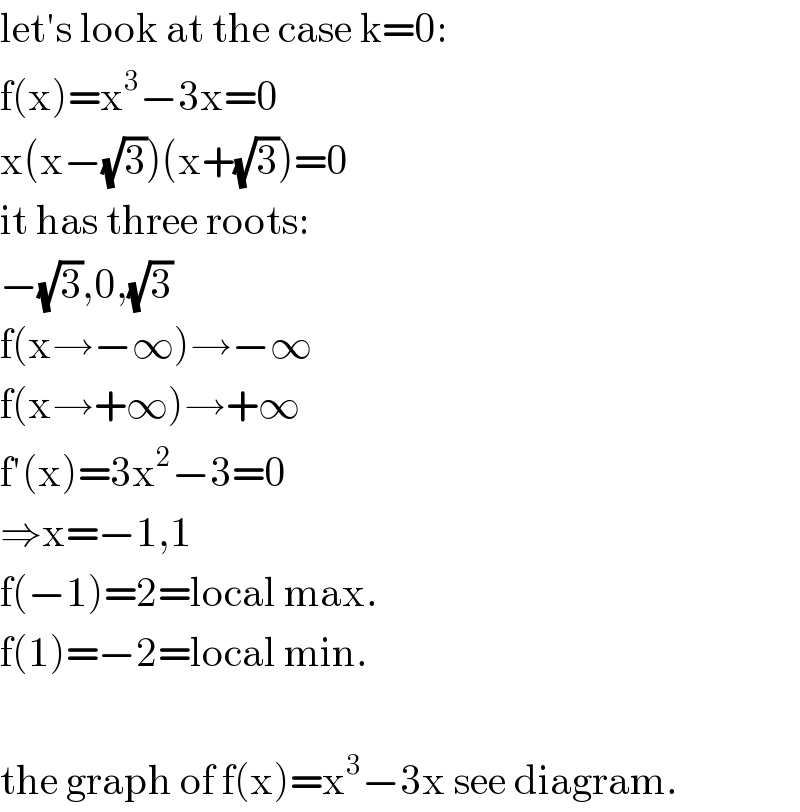Question Number 21070 by Tinkutara last updated on 11/Sep/17

$$\mathrm{Let}\:\mathrm{us}\:\mathrm{consider}\:\mathrm{an}\:\mathrm{equation}\:{f}\left({x}\right)\:=\:{x}^{\mathrm{3}} \\ $$$$−\:\mathrm{3}{x}\:+\:{k}\:=\:\mathrm{0}.\:\mathrm{Then}\:\mathrm{the}\:\mathrm{values}\:\mathrm{of}\:{k}\:\mathrm{for} \\ $$$$\mathrm{which}\:\mathrm{the}\:\mathrm{equation}\:\mathrm{has} \\ $$$$\mathrm{1}.\:\mathrm{Exactly}\:\mathrm{one}\:\mathrm{root}\:\mathrm{which}\:\mathrm{is}\:\mathrm{positive}, \\ $$$$\mathrm{then}\:{k}\:\mathrm{belongs}\:\mathrm{to} \\ $$$$\mathrm{2}.\:\mathrm{Exactly}\:\mathrm{one}\:\mathrm{root}\:\mathrm{which}\:\mathrm{is}\:\mathrm{negative}, \\ $$$$\mathrm{then}\:{k}\:\mathrm{belongs}\:\mathrm{to} \\ $$$$\mathrm{3}.\:\mathrm{One}\:\mathrm{negative}\:\mathrm{and}\:\mathrm{two}\:\mathrm{positive}\:\mathrm{root} \\ $$$$\mathrm{if}\:{k}\:\mathrm{belongs}\:\mathrm{to} \\ $$
Commented by Tinkutara last updated on 12/Sep/17

$$\mathrm{Thank}\:\mathrm{you}\:\mathrm{very}\:\mathrm{much}\:\mathrm{Sir}! \\ $$
Commented by mrW1 last updated on 12/Sep/17

$$\mathrm{1}.\:\mathrm{k}\in\left(−\infty,−\mathrm{2}\right) \\ $$$$\mathrm{2}.\:\mathrm{k}\in\left(\mathrm{2},+\infty\right) \\ $$$$\mathrm{3}.\:\mathrm{k}\in\left(\mathrm{0},\mathrm{2}\right) \\ $$
Answered by mrW1 last updated on 12/Sep/17

$$\mathrm{let}'\mathrm{s}\:\mathrm{look}\:\mathrm{at}\:\mathrm{the}\:\mathrm{case}\:\mathrm{k}=\mathrm{0}: \\ $$$$\mathrm{f}\left(\mathrm{x}\right)=\mathrm{x}^{\mathrm{3}} −\mathrm{3x}=\mathrm{0} \\ $$$$\mathrm{x}\left(\mathrm{x}−\sqrt{\mathrm{3}}\right)\left(\mathrm{x}+\sqrt{\mathrm{3}}\right)=\mathrm{0} \\ $$$$\mathrm{it}\:\mathrm{has}\:\mathrm{three}\:\mathrm{roots}: \\ $$$$−\sqrt{\mathrm{3}},\mathrm{0},\sqrt{\mathrm{3}} \\ $$$$\mathrm{f}\left(\mathrm{x}\rightarrow−\infty\right)\rightarrow−\infty \\ $$$$\mathrm{f}\left(\mathrm{x}\rightarrow+\infty\right)\rightarrow+\infty \\ $$$$\mathrm{f}'\left(\mathrm{x}\right)=\mathrm{3x}^{\mathrm{2}} −\mathrm{3}=\mathrm{0} \\ $$$$\Rightarrow\mathrm{x}=−\mathrm{1},\mathrm{1} \\ $$$$\mathrm{f}\left(−\mathrm{1}\right)=\mathrm{2}=\mathrm{local}\:\mathrm{max}. \\ $$$$\mathrm{f}\left(\mathrm{1}\right)=−\mathrm{2}=\mathrm{local}\:\mathrm{min}. \\ $$$$ \\ $$$$\mathrm{the}\:\mathrm{graph}\:\mathrm{of}\:\mathrm{f}\left(\mathrm{x}\right)=\mathrm{x}^{\mathrm{3}} −\mathrm{3x}\:\mathrm{see}\:\mathrm{diagram}. \\ $$
Commented by mrW1 last updated on 12/Sep/17

Commented by mrW1 last updated on 13/Sep/17

$$\mathrm{with}\:\mathrm{k}\neq\mathrm{0}\:\mathrm{the}\:\mathrm{graph}\:\mathrm{will}\:\mathrm{be}\:\mathrm{moved}\:\mathrm{up} \\ $$$$\left(\mathrm{k}>\mathrm{0}\right)\:\mathrm{or}\:\mathrm{down}\:\left(\mathrm{k}<\mathrm{0}\right). \\ $$$$\mathrm{1}.\:\mathrm{so}\:\mathrm{that}\:\mathrm{there}\:\mathrm{is}\:\mathrm{only}\:\mathrm{one}\:+\mathrm{ve}\:\mathrm{root}, \\ $$$$\mathrm{the}\:\mathrm{graph}\:\mathrm{must}\:\mathrm{be}\:\mathrm{moved}\:\mathrm{down}\:\mathrm{at}\:\mathrm{least} \\ $$$$\mathrm{by}\:\mathrm{2}\:\mathrm{units},\:\mathrm{i}.\mathrm{e}.\:\mathrm{k}<−\mathrm{2} \\ $$$$\mathrm{2}.\:\mathrm{so}\:\mathrm{that}\:\mathrm{there}\:\mathrm{is}\:\mathrm{only}\:\mathrm{one}\:−\mathrm{ve}\:\mathrm{root}, \\ $$$$\mathrm{the}\:\mathrm{graph}\:\mathrm{must}\:\mathrm{be}\:\mathrm{moved}\:\mathrm{up}\:\mathrm{at}\:\mathrm{least} \\ $$$$\mathrm{by}\:\mathrm{2}\:\mathrm{units},\:\mathrm{i}.\mathrm{e}.\:\mathrm{k}>\mathrm{2} \\ $$$$\mathrm{3}.\:\mathrm{so}\:\mathrm{that}\:\mathrm{there}\:\mathrm{are}\:\mathrm{2}\:+\mathrm{ve}\:\mathrm{roots}\:\mathrm{and}\:\mathrm{one}\:−\mathrm{ve}\:\mathrm{root}, \\ $$$$\mathrm{the}\:\mathrm{graph}\:\mathrm{must}\:\mathrm{be}\:\mathrm{moved}\:\mathrm{up},\:\mathrm{but} \\ $$$$\mathrm{by}\:\mathrm{less}\:\mathrm{than}\:\mathrm{2}\:\mathrm{units},\:\mathrm{i}.\mathrm{e}.\:\mathrm{0}<\mathrm{k}<\mathrm{2}. \\ $$
Commented by Tinkutara last updated on 13/Sep/17

$$\mathrm{Thank}\:\mathrm{you}\:\mathrm{very}\:\mathrm{much}\:\mathrm{Sir}! \\ $$
